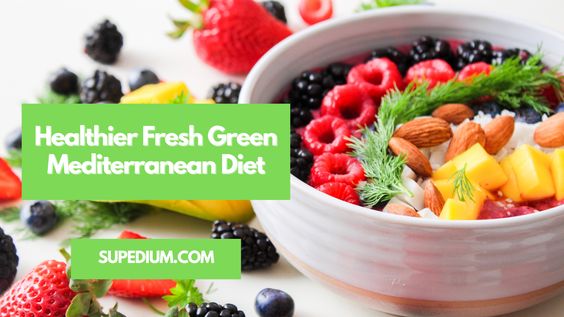Table of Contents
![]()
The “green” Mediterranean diet can be much better for you than the conventional Mediterranean diet.
This is according to a recent report published online in the journal Heart.
Researchers said they observed that people who ate higher levels of plant-based protein and fewer red meat and poultry had improved cardiovascular and metabolic benefits.
The researchers randomly allocated 294 sedentary people with moderate obesity (defined as the BMI of 31) to three dietary classes.
A vast majority of the participants were male. Their average age was 51 years.
The first party obtained advice on improving physical exercise and basic guidance on achieving a balanced diet.
The second party got the same guidelines on physical exercise and recommendations on the calorie-restricted, conventional Mediterranean diet.
Their menu was low in basic carbs, high in fruits, and poultry and seafood replacing red meat.
The third party got all of the above, including 3 to 4 cups of green tea and 28 grammes of walnuts a day.
The daily menu also included 100 grammes of frozen Wolffia globosa (cultivated Mankai strain) cubes, a high protein type of aquatic plant duckweed.
The cubes were used as a green plant-based protein shake as a partial replacement for animal protein.
The authors of the study said in a press release that their results recommend further reducing the consumption of meat while growing plant-based, protein-rich foods could further support the cardiometabolic state.
It may minimise cardiovascular risk beyond the known protective effects of the conventional Mediterranean diet.
Outcomes Show Healthy Promise
After 6 months, the “green Med” diet matched the other two food plans for related health benefits.
Participants of any form of Mediterranean diet lost more weight. The green group Med lost a total of 6.2 kilogrammes, the conventional Mediterranean diet group lost 5.4 kilogrammes and the balanced diet group lost 1.5 kilogrammes.
Waist circumference reduced by an average of 8.6 centimetres for those on the green Med diet compared to 6.8 centimetres for those on the Mediterranean diet and 4.3 centimetres for those on a balanced diet.
The Green Med group also had the highest decline in LDL (bad cholesterol with a drop of almost 4 per cent.
The comparable estimates were almost 1% for those in the Mediterranean diet group and even fewer for those in the balanced diet group.
Participants in Mediterranean diets have reaped additional health benefits, including reductions in diastolic blood pressure, insulin tolerance, and a significant marker of inflammation, C-reactive protein, which plays a vital role in artery hardening.
The ratio of HDL (good cholesterol to LDL (bad cholesterol has also risen.
Health experts are weighed in
The Mediterranean diet is now known for its ability to decrease the incidence of heart disease as well as stroke, diabetes, obesity and some cancers.
But why is that?
It boils down to the polyphenols that are found in plant matter.
Andy De Santis, a licenced dietitian with a master’s degree in public health nutrition, said, “Polyphenols are widely known for their potent anti-inflammatory and antioxidant capabilities, and recent research suggests that they may also have ‘prebiotic’ effects in our intestines, which act as a source of sustenance for our healthy intestinal bacteria.”
“In other words, you want a lot of polyphenol-containing foods in your diet,” said Healthline.
Experts say that you will also want to change the methods of protein intake.
“The traditional Med diet emphasises fish and seafood as the primary source of animal protein, with a smaller role for poultry, eggs and milk and an even smaller role for red meat,” De Santis said.
“The green Med diet appears to completely remove red meat and encourage other animal protein sources as well as plant-based proteins at the foundation of the diet (nuts, seeds, legumes) to take their place,” he added.
“This includes processed red meats such as salami, sausage, hot dogs, and so on, which are the types of red meat most often associated with negative health consequences due to their high sodium levels, preservatives and saturated fat content,” De Santis added.
Kristin Kirkpatrick, MS, RDN, a certified, registered dietitian and author of “Skinny Liver,” see the takeaway analysis in the same way.
“The original version allows chicken and fish, while it seems to be in keeping with the traditional components of the Mediterranean diet while opting for a more strict vegetarian approach,” she said to Healthline.
Drive for plant-based protein
“Diversifying your protein intake is one of the most powerful things a person can do to improve their health,” De Santis said.
“Primary plant protein sources, such as legumes, nuts, seeds and soya-based foods, offer unique benefits that are simply not found in animal foods,” he said.
Nuts are making a big difference.
“People who consume more nuts, seeds, and legumes have serious health benefits because of healthy fats, dietary fibre, antioxidants, and a wide range of vitamins/minerals,” De Santis stated.
“With that being said, no one says that you have to drop all the animal protein to be healthy,” he said. “However you should think about the balance between plant and animal protein consumption throughout your life.”
There are some health benefits for meat.
“There’s some balancing work to be done for most people,” De Santis said. “In addition to being widely enjoyed, however, animal protein also has nutritional value, particularly about its iron, protein and B12 content.”
“Fish, particularly rich in elusive vitamin D and omega-3s, is a very useful food,” he said.
What you ought to eat
Kirkpatrick said she told her clients, “Don’t overthink their food.”
That being said, there are several ways to increase polyphenols and plant-based proteins daily.
De Santis stated that seasonings, fruits, vegetables, legumes, nuts, seeds, tea, wine, and whole grains such as wheat and rye are polyphenols associated with the positive effects on cardiovascular and metabolic health identified in the study.
Kirkpatrick said that she recommends that people consume more whole soya, such as tempeh and tofu, as well as beans and lentils, nutritional yeast, nuts and spirulina (a nutrient-dense, nontoxic, blue-green algae).
“We need these foods] because protein is an essential component of good health, including muscle maintenance, energy supply and maintenance of the building blocks of all cells,” she said.
Kirkpatrick said food examples include a plate of hummus, whole wheat pita and falafel, bean pasta with vegan pesto or basic tomato sauce, or tahini with roasted vegetables and quinoa.
Share This





Be the first to comment